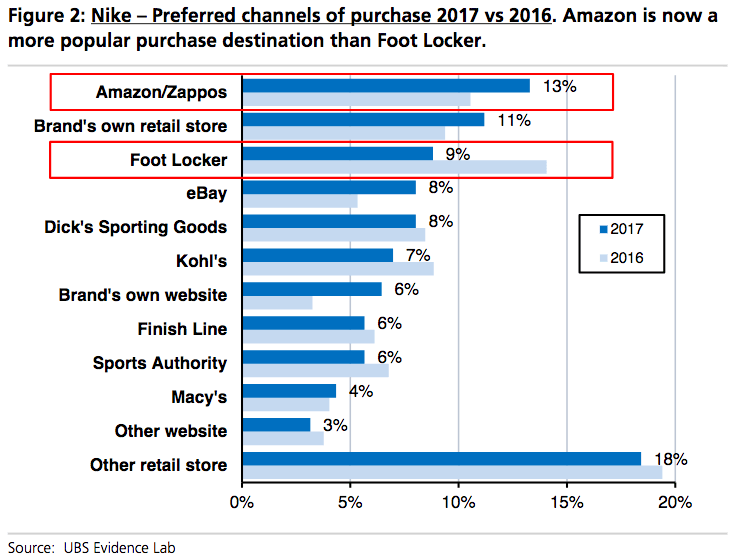![]()
Sneaker retailers are facing a perfect storm. (pic via BI from Bennett Raglin/AP)
Source: Amazon is about to claim a new victim in the retail apocalypse – Business Insider
The source article fails to cover a few points I recently made in my analysis of the Foot Locker stock plunge:
Foot Locker’s Stock Plunge, How One Year Makes a Huge Difference | MarketWatch
At the root of Foot Locker, Finish Line and Hibbett Sports’ problems is not Amazon, yet. The root is the promotional environment looking to drive foot traffic and sales. Amazon is an obvious issue, especially for e-commerce growth, and I’ve said that on the site before, but one thing that analysts continue to miss is the importance of the promotion/sales to generate interest problem.
2 Reasons Nike Selling On Amazon Will Disrupt Foot Locker, Finish Line and Other Retail Outlets
In particular in urban markets which tend to be where Foot Locker is located Foot Locker doesn’t have a choice but to promote. The overlap of locations with stores like Jimmy Jazz, DTLR, Sneaker Villa and City Gear has forced the promo culture. These stores with a combined 700+ locations have an interesting overlap with Foot Locker stores in the U.S. No one is looking at this as a big threat because it’s not as easy to analyze as the charts delivered here on Business Insider looking solely at Nike and Amazon.
This chart basically summarizes what I established in the 2 reasons article above. Amazon and Nike’s brand registry will undoubtedly hurt Nike’s wholesale connections.
While every outlet has an opportunity to reach a bigger audience via e-commerce, the problem is ecommerce for Foot Locker and the others was in jeopardy the moment Nike began making a strong push into DTC. Note the chart above and the growth of sales for Amazon, eBay and DTC (brand’s own store/brands website).
The second situation not being considered as a disruption; the abundance of apps and startups entering the resale space and how there are more small percentages being eaten up and taken away from Foot Locker and other retail outlets. Take a look again at the chart above. Now let’s look at some different data involving apps/websites like GOAT (not shown below), StockX, and Kixify who have solid marketplaces that are actually becoming important cogs in the high end market. This doesn’t include shoes sold via Instagram and Facebook. Using an analysis of website traffic a quick comparison can be made between the online traffic of sportswear websites (starting with the best platform to the worst):
Total Visits monthly (data compiled using website traffic analysis)
Nike.com 77.3 Million
Complex.com 22.6 Million (Includes Solecollector.com 2.92 Million (Recently launched Slang Marketplace, sneakernews.com 6.06 Million, weartesters.com 989,000) Total = 32.58 Million
Footlocker.com 15.95 Million (affiliated sites Footaction.com 1.29 Million, champsports.com 3.85 Million, eastbay.com 6.24 Million and Kidsfootlocker.com 2.53 Million) Total = 29.86 Million
adidas.com 20.72 Million
Hypebeast.com 13.43 Million (subsite hbx.com 867,000) Total = 14.30 Million (recently IPO’d)
underarmour.com 9.85 Million
Finishline.com 9.51 Million
StockX.com 3.21 Million (startup formerly campless.com)
Jimmyjazz.com 2.47 Million
Kixify.com 1.56 Million
Hibbett.com 1.11 Million (Recently launched their ecommerce)
Citygear.com 431,000
DTLR.com 258,000
sneakervilla.com >12,000
There are 14 ecommerce sites above. Out of those 14 sites the brands have better DTC than their wholesale counterparts. Nike completely dominates the online sale of their products. When you factor in their growth of brick and mortar locations you begin to understand the problem in sneakers.
What is more eye opening than anything is that listed here in this list are “sneakerhead” websites such as Complex.com which actually garners a total of 32.58 Million visits every six months which includes Sole Collector, Weartesters.com, and SneakerNews at the number 2 spot ahead of Foot Locker. Complex has done what Hypebeast did. They have launched their own marketplace for sportswear/streetwear.
The “sneakerhead” online market is even more eye opening when you see that StockX and Kixify rank higher than brick and mortar retail outlets like Jimmy Jazz, City Gear, DTLR, Villa and Hibbett Sports.
I once wrote that sneakerheads are no longer a niche. They are the mainstream and any person who makes an argument against this is ignoring the shift to online retail.
Business Insider has generated a great discussion article, but leaving out these two points, the overlap of urban brick and mortar store locations and the growth of startup/online ecommerce, is hindering a more complete discussion.


this is a really good article. I remember looking at stockx, kixify and other online marketplaces as a threat to ebay but no one really paid any attention to it. And now there is going to be smaller marketplaces that are going to emerge i na few more years. Flightclub is in a very precarious and dangerous place right now. places like DTLR, jimmyJazz have major problems you and I know that they won’t address and the longer they wait, the worse it’s going to be for them. this is the time to push forward my friend
This is definitely the time.
What percentage of the sneaker buyer do you think are people who plan to resell them? Is it more than miniscule, if not, do you think this trend will continue?
Reselling is niche. It’s not a substantial part of the market. It’s probably a 1 billion dollar market according to some data analysts. What’s happened in footwear is that there are so many outlets to resell and sell that people are using the brick and mortar stores of the brands to buy and flip shoes. This contributes to retail locations being undercut and has made the online platforms above more of a business that is actually being invested in. StockX has a 2 million dollar investment from Dan Gilbert. Complex/Solecollector etc I think was sold for 100 million. Hypebeast IPO’d and GOAT garnered 12 million on investment. Stadium goods got 4 million. Reselling is everywhere, but it’s enough that brands are overproducing to stop it.